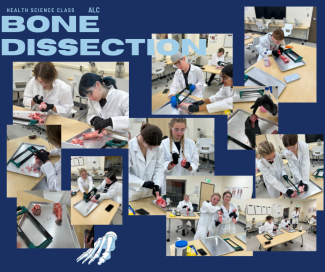Bone Dissection
Brian Blake led students in Anatomy and Physiology through a bone dissection.
Students learned the difference between compact bone, spongy bone and cartilage.
Students were able to see and feel bone marrow , one student saying it felt like butter.
Students learned that bone can bleed and that a hip replacement is actually a femur replacement.
What makes this activity so memorable?
The realization that bone has so many different properties to it. Such as the type of bone, red marrow and yellow marrow, and cartilage.
It was very interesting to see how the knee joint works and many students said that the thing that stood out the most was the feel of the bone marrow.



